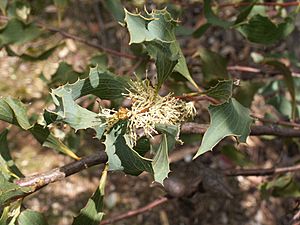Wavy-leaved hakea facts for kids
Quick facts for kids Wavy-leaved hakea |
|
|---|---|
 |
|
| Hakea undulata growing in John Forrest National Park. | |
| Scientific classification | |
| Genus: |
Hakea
|
| Species: |
undulata
|
| Synonyms | |
|
|
Hakea undulata, often called the wavy-leaved hakea, is a lovely flowering plant. It is part of the Proteaceae plant family. You can find it only in the south-west region of Western Australia. This plant is special because of its stiff, wavy leaves. It also grows fragrant cream-white flowers. These flowers bloom from the middle of winter until October.
Contents
What Does It Look Like?
The wavy-leaved hakea is a shrub that grows upright. It can be a bit straggly sometimes. It usually reaches a height of about 1 to 2 metres (3 to 7 feet). This plant does not have a special woody swelling at its base called a lignotuber. This means it cannot regrow easily after a fire.
Leaves and Branches
The smaller branches of the plant are smooth when it flowers. Its leaves are shaped like an oval or an egg. They are stiff and have prickly, scalloped edges. Each leaf is about 4 to 12 centimetres (1.6 to 4.7 inches) long. They are also 2 to 6 centimetres (0.8 to 2.4 inches) wide. The green-grey leaves have clear patterns of veins on both sides. They narrow down to long stalks at their base.
Flowers and Fruit
The plant produces a single group of 12 to 21 sweet-smelling flowers. These flowers are cream-white in colour. They grow in a cluster called a raceme on a smooth stalk (a pedicel). The flower's outer parts, called the perianth, are cream-white. The pistil, which is the female part of the flower, is about 3 to 4 millimetres (0.12 to 0.16 inches) long.
After flowering, the plant forms fruits. These fruits are shaped like an oval but are a bit slanted. They are about 2 to 3 centimetres (0.8 to 1.2 inches) long. They are also 1 to 2 centimetres (0.4 to 0.8 inches) wide. The fruit's surface is smooth but has small, blister-like bumps. It ends with a beak-like tip that points upwards. The flowers usually appear from July to October.
How It Got Its Name
The wavy-leaved hakea was first officially described in 1810. This was done by a botanist named Robert Brown. He wrote about it in a scientific paper called Transactions of the Linnean Society of London. The plant's scientific name, undulata, comes from a Latin word. "Undulatus" means "wavy," which describes the wavy edges of its leaves.
Where It Grows and Lives
The wavy-leaved hakea grows in Western Australia. You can find it from the Darling Ranges north of Perth. Its range extends south all the way to Albany. This plant likes to grow in scrubland and woodland areas. It can grow in sandy, loamy, or gravelly soils. Sometimes, it grows in clay soil over a hard layer called laterite. It can even grow near granite rocks.
This hakea needs a sunny spot to grow well. It also needs soil that drains water easily. It is a good plant to use for hedges. It also provides a nice home for local wildlife.
Is It Protected?
The Western Australian Government has looked at the Hakea undulata. They have classified it as "not threatened." This means it is not currently at risk of disappearing.
See also

